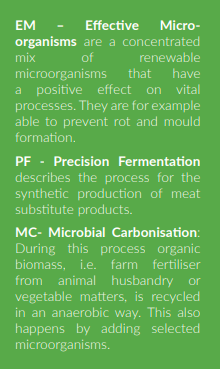What could the agriculture of the future be like? In what way does agriculture contribute to climate protection? What will society demand from the farmers? Michael Horsch also asks himself all these questions and provides some answers.

Strategies for a positive contribution to the climate protection
I have become a little bit tired of the topic future. For we already are right in the middle of it! Currently there are the most different activities with regard to CO2. Let’s take a look for example at the organic associations that have turned humus management into a central topic. The question I wonder about is: How can we manage to store permanent humus – as the word implies – permanently in the soil and not only try to build up nutritive humus? For this kind of humus decomposes rather quickly. Moreover, we need a certification that is acknowledged by the carboncertificate buyers.
At the moment, there is a lot of potential for the certificate buyers among the automobile manufacturers or in the food retailing sector. The food retailers do not only pursue CO2 neutrality, but even think about offering CO2 positive food. They might succeed by promoting products from farmers who demonstrably increase CO2 in the soil.
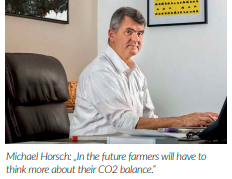
Just imagine the effect this will have on the consumer. The latter more and more worries about our climate and he prefers to buy regional food that has been produced in a humus encouraging way than food that is promoted with carbon certificates for the planting of trees in Indonesia or the Himalayas.
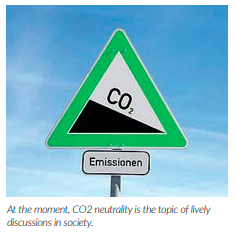
Can the agricultural engineering sector support the farmers with regard to >CO2?
I am in two minds about this question. For on the one hand, we achieved a lot with regard to the CO2 footprint of diesel engines. But on the other hand, it feels like a drop in the ocean. In farming for example, we today need approximately 100 litres of diesel/ha. This corresponds to about 300 kg CO2/ha. With better engines and better gear units we saved perhaps 20 l/ha or 60 kg/ha of CO2. However, if this is compared with another cultivation system that we as agricultural engineers can also influence to a great extent, it would definitely be possible to save 5,000 to 10,000 kg/ha of CO2 in the soil each year. In comparison, a saving of 60 kg/ ha is only marginal.
Will CO2 be one of the central topics for farmers in the future?
The climate change could be another opportunity for us farmers to get together with society. In the past 100 years two times we came to a point when agricultural research was keen to build up humus: in 1920 after the First World War because of the famine and then again in 1950 after the Second World War. At that time, it was up to the agricultural sector to supply the population with enough food. The production of humus was a top priority.
At the beginning of the 1960s, tractors, fertiliser, chemistry and plant breeding entered the picture and the yields started to grow constantly. Humus was of secondary importance. Some critics accused the farmers that they even depleted humus. This, however, was not the case. Due to the considerably increasing yields in the 70s, 80s and 90s the nutrient humus values even increased, too.
Do the objectives of modern agriculture have to change to meet the current requirements?
We, of course, wonder if yields will continue to increase by 1 % per year. Until ten years ago this was the case for rape, wheat, barley rotations in Western Europe. Now we notice that yields stagnate in some regions, i.e. in Southern Germany, Central France or East England. It might perhaps be an alternative for Michael Horsch: „In the future farmers will have to many farmers to generate additional income by producing humus. But this will not necessarily be compatible with the principle of an absolute yield maximisation. And it will not work in every region. If today certificates are traded with up to 50 €/t or in the future perhaps with up to 250 to 500 €/ha, it is worth thinking about. I am sure it would be well received by society if farmers would get 500 €/ ha for the production of humus instead of 300 €/ha as a subsidy.
Opinions on glyphosate and Humus
From a political point of view, glyphosate is all but banned in Western Europe, at least at the moment. Small quantities of glyphosate as a partial replacement of tillage would absolutely be an environmentally friendly contribution to erosion protection and humus production. I have heard some anti-glyphosate activists say that they agree.
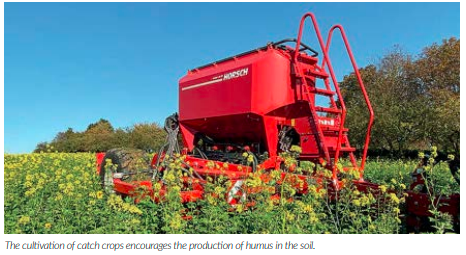
However, as long as roundup soya and roundup maize are grown in North and South America and as long as they use the largest quantities of glyphosate, no anti-glyphosate activist will warm to this idea. Which consequences might the increased use of microorganisms (EM) have on the soil and the plants? It is not new to breed special bacteria, fungi and enzymes that can be found in nature and apply them on the plant. What is new is that with today’s biotechnology we can better explain what happens and how we can use it.
But we have to be aware of the fact that there still is only little basic research and a lot is based on the empirical experiences of practical experts. However, in our opinion this is an ingenious field of activity that allows for understanding and using correlations in the soil and the positive effect on the plant in a better way – for example to reduce fungicides and insecticides until they one day can be replaced completely. At the moment we are observing this procedure at the large soya farms in Brazil. The integration of micro-organisms could be another approach for the production of permanent humus. Microbial carbonisation could soon become one of the major topics. „In the future farmers will have to think more about their CO2 balance.“
HORSCH’s contribution
By continuing to focus on the topics we have been dealing with for quite some time. I always talk about topics like CO2, EM, MC, nutrient density in food or residue-free food. We have to fill these topics with life. That’s what especially our customers want us to do. Moreover, we also concentrate on organic farming. And we are curious how hybrid farming will develop. Insights from the organic sector and established practices from conventional farming are merged and perhaps, in combination with modern biotechnology, a completely new way of producing food might develop.
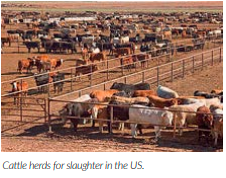
Humus management, animal husbandry and meat consumption in the future It will be exciting. For PF (Precision Fermentation) and flexitarism (less animal food, but vegetable food instead) are on the rise. Think tanks predict that ten years from now PF will replace 50 % of the beef in the US alone. I would not worry too much about it. However, if only 10 % of these predictions will come true, the soya and maize producers in the US and in Brazil will have to face difficult times. But I still think that conventional and organic farmers who produce regionally and sustainably must not be afraid of the future. They understand best what the consumer demands from them.
